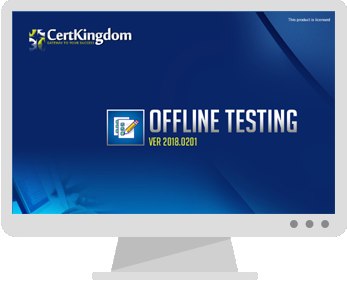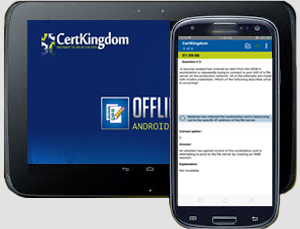Exam: 70-342

|
|||||||||||||||||||||||||||
Certkingdom's preparation material includes the most excellent features, prepared by the same dedicated experts who have come together to offer an integrated solution. We provide the most excellent and simple method to pass your certification exams on the first attempt "GUARANTEED"
Whether you want to improve your skills, expertise or career growth, with Certkingdom's training and certification resources help you achieve your goals. Our exams files feature hands-on tasks and real-world scenarios; in just a matter of days, you'll be more productive and embracing new technology standards. Our online resources and events enable you to focus on learning just what you want on your timeframe. You get access to every exams files and there continuously update our study materials; these exam updates are supplied free of charge to our valued customers. Get the best 70-342 exam Training; as you study from our exam-files "Best Materials Great Results"
70-342 Exam + Online / Offline and Android Testing Engine & 4500+ other exams included
$50 - $25 (you save $25)
Buy Now
Exam 70-342
Advanced Solutions of Microsoft Exchange Server 2013
Audiences: IT professionals
Technology Microsoft Exchange Server 2013
Credit toward certification: MCP, MCSE
This Training cover
This exam measures your ability to accomplish the technical tasks listed below. The percentages indicate the relative weight of each major topic area on the exam. The higher the percentage, the more questions you are likely to see on that content area on the exam. View video tutorials about the variety of question types on Microsoft exams.
Please note that the questions may test on, but will not be limited to, the topics described in the bulleted text.
Do you have feedback about the relevance of the skills measured on this exam? Please send Microsoft your comments. All feedback will be reviewed and incorporated as appropriate while still maintaining the validity and reliability of the certification process. Note that Microsoft will not respond directly to your feedback. We appreciate your input in ensuring the quality of the Microsoft Certification program.
If you have concerns about specific questions on this exam, please submit an exam challenge.
Starting July 2014, the questions on this exam include content covering Microsoft Exchange Server 2013 Service Pack 1.
Configure, manage, and migrate Unified Messaging (20%)
Configure Unified Messaging (UM)
Configure an IP gateway; configure a UM call router; create and configure an auto attendant; configure a call answering rule; design UM for high availability; create a dial plan
Manage Unified Messaging
Assign a dial plan to a user; move users between dial plans; enable and disable UM features for a user; set up protected voice mail; configure UM mailbox policy; manage UM language packs
Troubleshoot Unified Messaging
Troubleshoot and configure Mutual Transport Layer Security (MTLS); monitor calls and call statistics; troubleshoot and configure Quality of Service (QoS); troubleshoot SIP communication
Migrate Unified Messaging
Prepare to migrate; plan a migration strategy; plan a coexistence strategy; move UM mailboxes between sites; redirect the SIP gateway to Exchange; decommission the legacy system
Preparation resources
Deploy Exchange 2013 UM
Exchange Server 2013 and Unified Messaging - Part 1 - deploying and configuring
UM reports procedures
Design, configure, and manage site resiliency (22%)
Manage a site-resilient Database Availability Group (DAG)
Plan and implement Datacenter Activation Coordination (DAC); given customer node requirements, recommend quorum options; plan cross-site DAG configuration; configure DAG networks
Design, deploy, and manage a site-resilient CAS solution
Plan site-resilient namespaces; configure site-resilient namespace URLs; perform steps for site *over; plan certificate requirements for site failovers; predict client behavior during a *over
Design, deploy, and manage site resilience for transport
Configure MX records for failover scenarios; manage resubmission and reroute queues; plan and configure Send/Receive connectors for site resiliency; perform steps for transport *over
Troubleshoot site-resiliency issues
Resolve quorum issues; troubleshoot proxy redirection issues; troubleshoot client connectivity; troubleshoot mail flow; troubleshoot data center activation; troubleshoot DAG replication
Preparation resources
Microsoft Exchange Server 2013: Managing high availability and site resilience
Planning for high availability and site resilience
Database availability groups
Design, configure, and manage advanced security (21%)
Select an appropriate security strategy
Evaluate role-based access control (RBAC); evaluate BitLocker; evaluate smart cards; evaluate Information Rights Management (IRM); evaluate S/MIME; evaluate Domain Secure/TLS
Deploy and manage IRM with Active Directory Rights Management Services (AD RMS)
Create an AD RMS template; create transport protection rules; create Outlook protection rules; configure transport decryption; configure IRM for discovery; configure pre-licensing for client access
Configure and interpret mailbox and administrative auditing
Configure mailbox audit logging; configure administrative audit logging; configure mailbox access logging; interpret all audit logs
Troubleshoot security-related issues
Determine certificate validity; ensure proper Certificate Revocation List (CRL) access and placement; ensure private key availability; troubleshoot failed IRM protection; troubleshoot RBAC
Preparation resources
Information Rights Management
Mailbox audit logging
Configure and manage compliance, archiving, and discovery solutions (20%)
Configure and manage an archiving solution
Set up online archiving (Office 365); create archive policies; set up on-premises archiving; plan storage for an archiving solution
Design and configure Data Loss Prevention (DLP) solutions
Set up pre-built rules; set up custom rules; design a DLP solution to meet business requirements; set up custom policies
Configure and administer Message Records Management (MRM)
Design retention policies; configure retention policies; create and configure custom tags; assign policies to users; configure the Managed Folder Assistant; remove and delete tags
Perform eDiscovery
Plan and delegate RBAC roles for eDiscovery; enable a legal/litigation hold; perform a query-based InPlace hold; design and configure journaling; perform multi-mailbox searches in Exchange Administration Center (EAC); evaluate how to integrate InPlace federated searches with Microsoft SharePoint
Implement a compliance solution
Design and configure transport rules for ethical walls; configure MailTips; create, configure, and deploy message classifications; design and configure transport rules to meet specified compliance requirements
Preparation resources
Exchange Server 2013: Archive with elegance
Microsoft Exchange Server 2013 data loss prevention
Messaging records management
Implement and manage coexistence, hybrid scenarios, migration, and federation (18%)
Establish coexistence with Exchange Online
Deploy and manage hybrid configuration; evaluate limitations of the Hybrid Configuration Wizard; configure requirements for single sign-on (SSO); design and configure Active Directory Federation Services (ADFS)
Deploy and manage Exchange federation
Manage federation trusts with Microsoft federation gateways; manage hybrid deployment OAuth-based authentication; manage sharing policies; design certificate and firewall requirements; manage organization relationships
Implement on-premises coexistence with legacy systems
Plan namespaces for coexistence; configure proxy redirect; plan firewall configuration for coexistence; plan for mail flow requirements
Set up a cross-forest coexistence solution
Set up cross-forest availability; design certificate and firewall requirements; set up cross-forest mail flow; design and configure AutoDiscover; set up shared namespaces
Migrate legacy systems
Determine transition paths to Exchange; migrate public folders; migrate mailboxes; upgrade policies; plan to account for discontinued features; transition and decommission server roles
Troubleshoot issues associated with hybrid scenarios, coexistence, migration, and federation
Troubleshoot transport; troubleshoot Exchange federation trust and organization relationships; troubleshoot client access; troubleshoot SSO/AD FS; troubleshoot DirSync; troubleshoot cross-forest availability
Preparation resources
Exchange Server 2013 hybrid deployments
Configure the Availability service for cross-forest topologies
Public Folder procedures
Make yourself more valuable in today's competitive computer industry Certkingdom's preparation material includes the most excellent features, prepared by the same dedicated experts who have come together to offer an integrated solution. We provide the most excellent and simple method to pass your Microsoft MCSE: Messaging 70-342 exam on the first attempt "GUARANTEED".
Unlimited Access Package
will prepare you for your exam with guaranteed results, 70-342 Study Guide. Your exam will download as a single 70-342 PDF or complete 70-342 testing engine as well as over +4000 other technical exam PDF and exam engine downloads. Forget buying your prep materials separately at three time the price of our unlimited access plan - skip the 70-342 audio exams and select the one package that gives it all to you at your discretion: 70-342 Study Materials featuring the exam engine.
Certkingdom 70-342 Exam Prepration Tools
Certkingdom Microsoft MCSE: Messaging preparation begins and ends with your accomplishing this credential goal. Although you will take each Microsoft MCSE: Messaging online test one at a time - each one builds upon the previous. Remember that each Microsoft MCSE: Messaging exam paper is built from a common certification foundation.
70-342 Exam Testing Engines
Beyond knowing the answer, and actually understanding the 70-342 test questions puts you one step ahead of the test. Completely understanding a concept and reasoning behind how something works, makes your task second nature. Your 70-342 quiz will melt in your hands if you know the logic behind the concepts. Any legitimate Microsoft MCSE: Messaging prep materials should enforce this style of learning - but you will be hard pressed to find more than a Microsoft MCSE: Messaging practice test anywhere other than Certkingdom.
70-342 Exam Questions and Answers with Explanation
This is where your Microsoft MCSE: Messaging 70-342 exam prep really takes off, in the testing your knowledge and ability to quickly come up with answers in the 70-342 online tests. Using MCSE: Messaging 70-342 practice exams is an excellent way to increase response time and queue certain answers to common issues.
70-342 Exam Study Guides
All Microsoft MCSE: Messaging online tests begin somewhere, and that is what the Microsoft MCSE: Messaging training course will do for you: create a foundation to build on. Study guides are essentially a detailed Microsoft MCSE: Messaging 70-342 tutorial and are great introductions to new Microsoft MCSE: Messaging training courses as you advance. The content is always relevant, and compound again to make you pass your 70-342 exams on the first attempt. You will frequently find these 70-342 PDF files downloadable and can then archive or print them for extra reading or studying on-the-go.
70-342 Exam Video Training
For some, this is the best way to get the latest Microsoft MCSE: Messaging 70-342 training. However you decide to learn 70-342 exam topics is up to you and your learning style. The Certkingdom Microsoft MCSE: Messaging products and tools are designed to work well with every learning style. Give us a try and sample our work. You'll be glad you did.
70-342 Other Features
* Realistic practice questions just like the ones found on certification exams.
* Each guide is composed from industry leading professionals real Microsoft MCSE: Messagingnotes, certifying 100% brain dump free.
* Study guides and exam papers are guaranteed to help you pass on your first attempt or your money back.
* Designed to help you complete your certificate using only
* Delivered in PDF format for easy reading and printing Certkingdom unique CBT 70-342 will have you dancing the Microsoft MCSE: Messaging jig before you know it
* MCSE: Messaging 70-342 prep files are frequently updated to maintain accuracy. Your courses will always be up to date.
Get MCSE: Messaging ebooks from Certkingdom which contain real 70-342 exam questions and answers. You WILL pass your MCSE: Messaging exam on the first attempt using only Certkingdom's MCSE: Messaging excellent preparation tools and tutorials.
These are real testimonials. Hi friends! CertKingdom.com is No1 in sites coz in $50 I cant believe this but when I purchased the $50 package it was amazing I Microsoft passed 10 Exams using CertKingdom guides in one Month So many thanks to CertKingdom Team , Please continue this offer for next year also. So many Thanks
Mike CA
Thank You! I would just like to thank CertKingdom.com for the Microsoft MCSE: Messaging 70-342 test guide that I bought a couple months ago and I took my test and pass overwhelmingly. I completed the test of 233 questions in about 90 minutes I must say that their Q & A with Explanation are very amazing and easy to learn.
Jay Brunets
After my co-workers found out what I used to pass Microsoft MCSE: Messaging 70-342 the test, that many are thinking about purchasing CertKingdom.com for their MCSE: Messaging exams, I know I will again
John NA
I passed the Microsoft MCSE: Messaging 70-342 exam yesterday, and now it's on to security exam. Couldn't have done it with out you. Thanks very much.
Oley R.
Hello Everyone
I Just Passed The Microsoft MCSE: Messaging 70-342 Took 80 to 90 Minutes max to understand and easy to learn. Thanks For Everything Now On To 70-342
Robert R.
Hi CertKingdom.com thanks so much for your assistance in Microsoft MCSE: Messaging i passed today it was a breeze and i couldn't have done it without you. Thanks again
Seymour G.
I have used your Exam Study Guides for preparation for Microsoft MCSE: Messaging 70-342. I also passed all those on the first round. I'm currently preparing for the Microsoft and theMCSE: Messaging. exams
Ken T.
I just wanted to thank you for helping me get myMCSE: Messaging $50 package for all guides is awesome you made the journey a lot easier. I passed every test the first time using your Guide
Mario B.
I take this opportunity to express my appreciation to the authors of CertKingdom.com Microsoft MCSE: Messaging test guide. I purchased the 70-342 soon after my formal hands on training and honestly, my success in the test came out of nowhere but CertKingdom.com. Once again I say thanks
Kris H.
Dear CertKingdom.com team the test no. 70-342 that i took was very good, I received 880 and could have gain more just by learning your exams
Gil L.
Hi and Thanks I have just passed the MCSE: Messaging Directory Services Design exam with a score of 928 thanks to you! The guide was excellent
Edward T.
Great stuff so far....I love this site....!! I am also on the Microsoft MCSE: Messaging I decided to start from certkingdom and start learning study MCSE: Messaging from home... It has been really difficult but so far I have managed to get through 4 exams....., now currently studying for the more exams.... Have a good day.................................................. Cheers
Ted Hannam
Thanks for your Help, But I have finally downloaded Microsoft MCSE: Messaging 70-342 exam preparation from certkingdom.com they are provided me complete information about the exam, lets hope I get success for the 70-342 exam, I found there exams very very realistic and useful. thanks again
lindsay Paul
Certkingdom Offline Testing Engine Simulator Download
Prepare with yourself how CertKingdom Offline Exam Simulator it is designed specifically for any exam preparation. It allows you to create, edit, and take practice tests in an environment very similar to an actual exam.
Supported Platforms: Windows-7 64bit or later - EULA | How to Install?
FAQ's: Windows-8 / Windows 10 if you face any issue kinldy uninstall and reinstall the Simulator again.
Download Offline Simulator-Beta
Certkingdom Testing Engine Features
- Certkingdom Testing Engine simulates the real exam environment.
- Interactive Testing Engine Included
- Live Web App Testing Engine
- Offline Downloadable Desktop App Testing Engine
- Testing Engine App for Android
- Testing Engine App for iPhone
- Testing Engine App for iPad
- Working with the Certkingdom Testing Engine is just like taking the real tests, except we also give you the correct answers.
- More importantly, we also give you detailed explanations to ensure you fully understand how and why the answers are correct.
Certkingdom Android Testing Engine Simulator Download
Take your learning mobile android device with all the features as desktop offline testing engine. All android devices are supported.
Supported Platforms: All Android OS EULA
Install the Android Testing Engine from google play store and download the app.ck from certkingdom website android testing engine download

Certkingdom Android Testing Engine Features
- CertKingdom Offline Android Testing Engine
- Make sure to enable Root check in Playstore
- Live Realistic practice tests
- Live Virtual test environment
- Live Practice test environment
- Mark unanswered Q&A
- Free Updates
- Save your tests results
- Re-examine the unanswered Q & A
- Make your own test scenario (settings)
- Just like the real tests: multiple choice questions
- Updated regularly, always current




